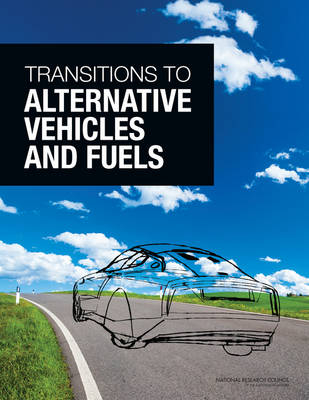
Transitions to Alternative Vehicles and Fuels
Seiten
2013
National Academies Press (Verlag)
978-0-309-26852-3 (ISBN)
National Academies Press (Verlag)
978-0-309-26852-3 (ISBN)
For a century, almost all light-duty vehicles (LDVs) have been powered by internal combustion engines operating on petroleum fuels. Energy security concerns about petroleum imports and the effect of greenhouse gas (GHG) emissions on global climate are driving interest in alternatives. Transitions to Alternative Vehicles and Fuels assesses the potential for reducing petroleum consumption and GHG emissions by 80 percent across the U.S. LDV fleet by 2050, relative to 2005.
This report examines the current capability and estimated future performance and costs for each vehicle type and non-petroleum-based fuel technology as options that could significantly contribute to these goals. By analyzing scenarios that combine various fuel and vehicle pathways, the report also identifies barriers to implementation of these technologies and suggests policies to achieve the desired reductions. Several scenarios are promising, but strong, and effective policies such as research and development, subsidies, energy taxes, or regulations will be necessary to overcome barriers, such as cost and consumer choice.
Table of Contents
Front Matter
Overview
Summary
1 Introduction
2 Alternative Vehicle Technologies: Status, Potential, and Barriers
3 Alternative Fuels
4 Consumer Attitudes and Barriers
5 Modeling the Transition to Alternative Vehicles and Fuels
6 Policies for Reducing GHG Emissions from and Petroleum Use by Light-Duty Vehicles
7 Policy Options
Appendixes
Appendix A: Statement of Task
Appendix B: Committee Biographies
Appendix C: Meetings and Presentations
Appendix D: Reports on Transportation Greenhouse Gas Emissions Projections to 2050
Appendix E: Glossary, Conversion Factors, and Acronyms and Abbreviations
Appendix F: Vehicles
Appendix G: Fuels
Appendix H: Modeling
This report examines the current capability and estimated future performance and costs for each vehicle type and non-petroleum-based fuel technology as options that could significantly contribute to these goals. By analyzing scenarios that combine various fuel and vehicle pathways, the report also identifies barriers to implementation of these technologies and suggests policies to achieve the desired reductions. Several scenarios are promising, but strong, and effective policies such as research and development, subsidies, energy taxes, or regulations will be necessary to overcome barriers, such as cost and consumer choice.
Table of Contents
Front Matter
Overview
Summary
1 Introduction
2 Alternative Vehicle Technologies: Status, Potential, and Barriers
3 Alternative Fuels
4 Consumer Attitudes and Barriers
5 Modeling the Transition to Alternative Vehicles and Fuels
6 Policies for Reducing GHG Emissions from and Petroleum Use by Light-Duty Vehicles
7 Policy Options
Appendixes
Appendix A: Statement of Task
Appendix B: Committee Biographies
Appendix C: Meetings and Presentations
Appendix D: Reports on Transportation Greenhouse Gas Emissions Projections to 2050
Appendix E: Glossary, Conversion Factors, and Acronyms and Abbreviations
Appendix F: Vehicles
Appendix G: Fuels
Appendix H: Modeling
1 Front Matter; 2 Overview; 3 Summary; 4 1 Introduction; 5 2 Alternative Vehicle Technologies: Status, Potential, and Barriers; 6 3 Alternative Fuels; 7 4 Consumer Attitudes and Barriers; 8 5 Modeling the Transition to Alternative Vehicles and Fuels; 9 6 Policies for Reducing GHG Emissions from and Petroleum Use by Light-Duty Vehicles; 10 7 Policy Options; 11 Appendixes; 12 Appendix A: Statement of Task; 13 Appendix B: Committee Biographies; 14 Appendix C: Meetings and Presentations; 15 Appendix D: Reports on Transportation Greenhouse Gas Emissions Projections to 2050; 16 Appendix E: Glossary, Conversion Factors, and Acronyms and Abbreviations; 17 Appendix F: Vehicles; 18 Appendix G: Fuels; 19 Appendix H: Modeling
| Verlagsort | Washington |
|---|---|
| Sprache | englisch |
| Maße | 216 x 279 mm |
| Themenwelt | Naturwissenschaften ► Geowissenschaften ► Meteorologie / Klimatologie |
| Naturwissenschaften ► Physik / Astronomie | |
| Technik ► Elektrotechnik / Energietechnik | |
| ISBN-10 | 0-309-26852-4 / 0309268524 |
| ISBN-13 | 978-0-309-26852-3 / 9780309268523 |
| Zustand | Neuware |
| Haben Sie eine Frage zum Produkt? |
Mehr entdecken
aus dem Bereich
aus dem Bereich
Grundlagen – Maßnahmen – Planungen
Buch | Hardcover (2021)
Springer Fachmedien Wiesbaden GmbH (Verlag)
CHF 209,95
das Wolkenbuch für alle
Buch | Softcover (2024)
Seifert Verlag
CHF 27,95
A User Guide for Offshore Renewables and Oil & Gas
Buch | Hardcover (2024)
Whittles Publishing (Verlag)
CHF 78,55


